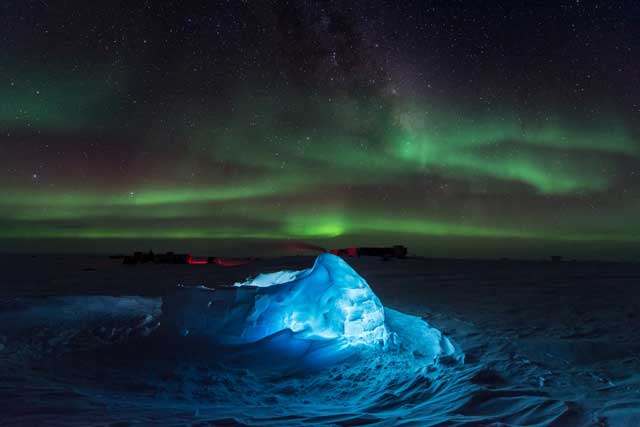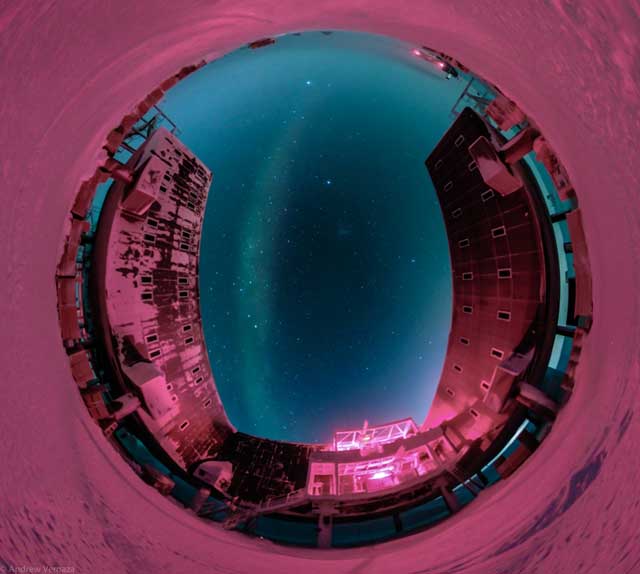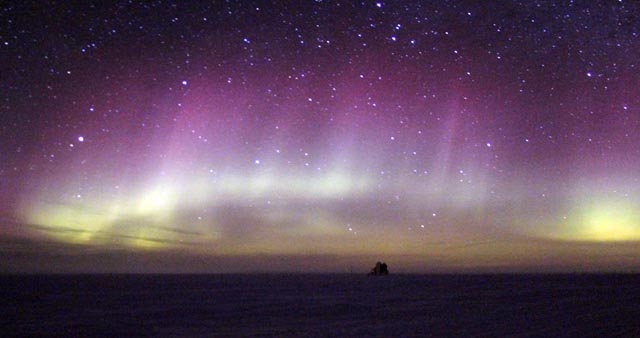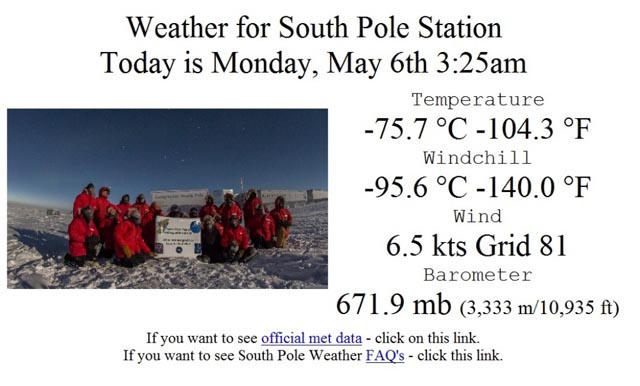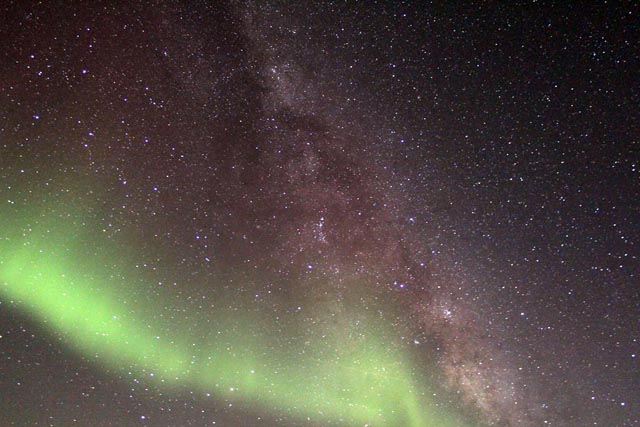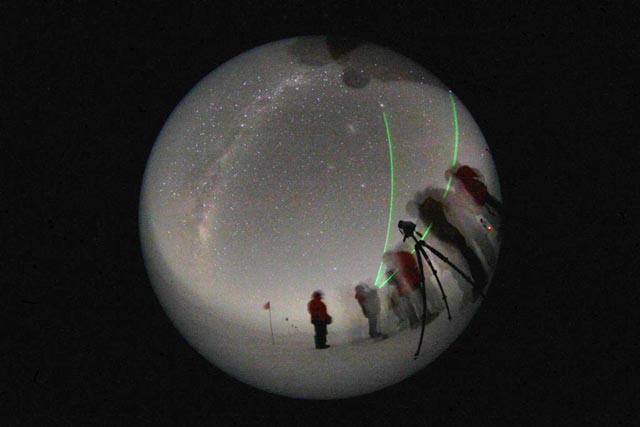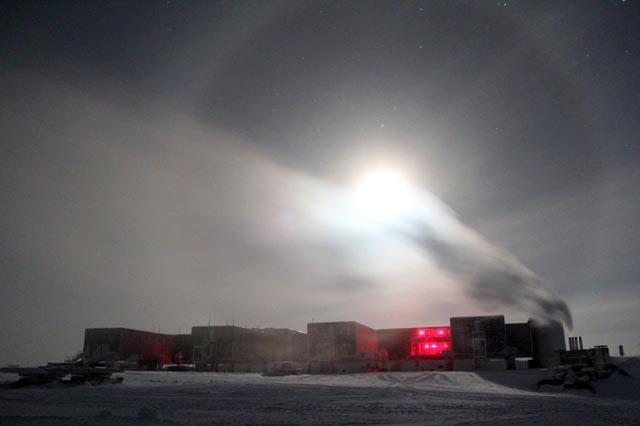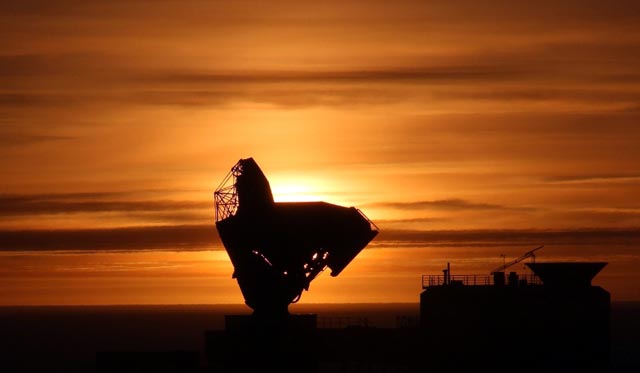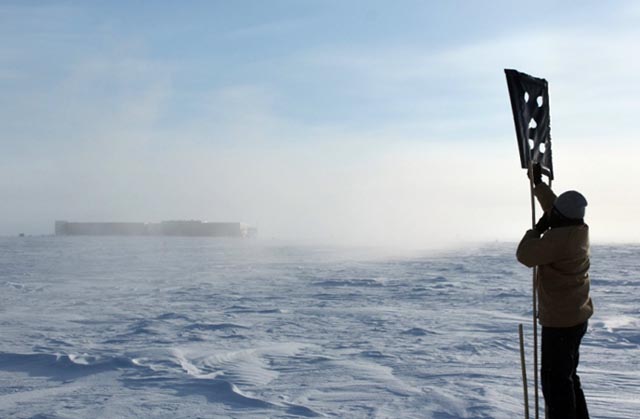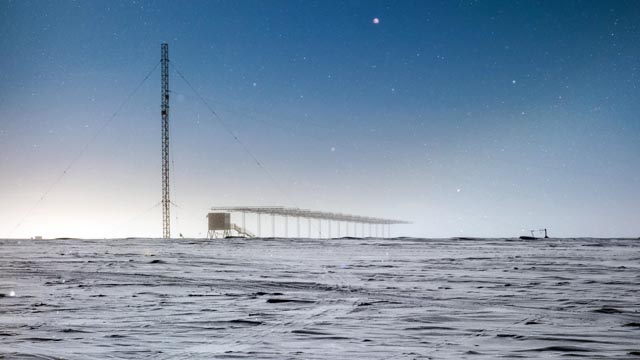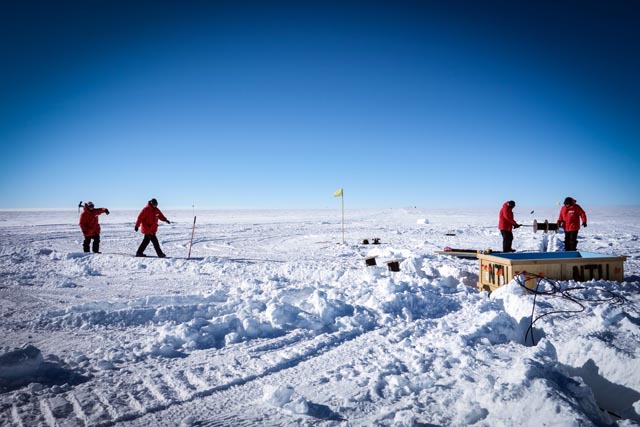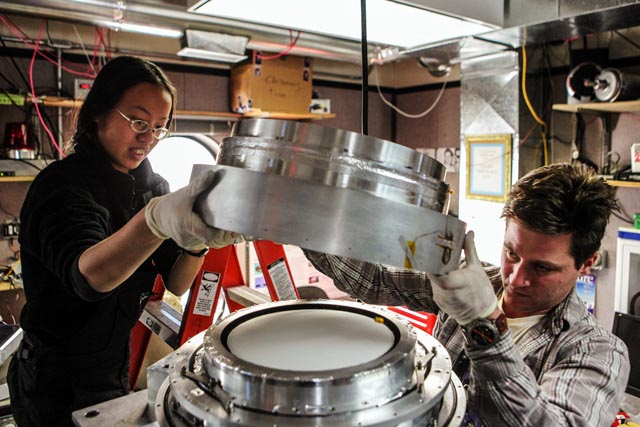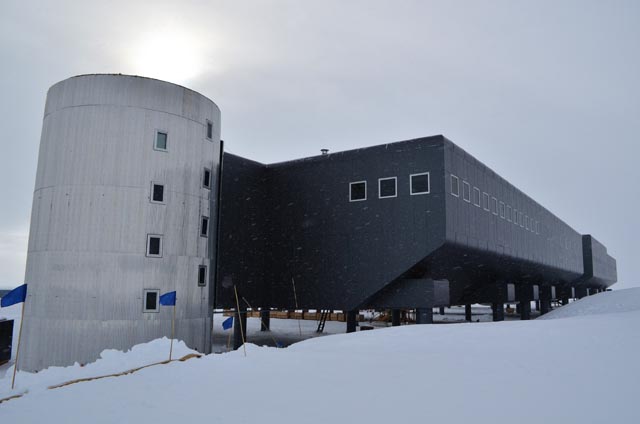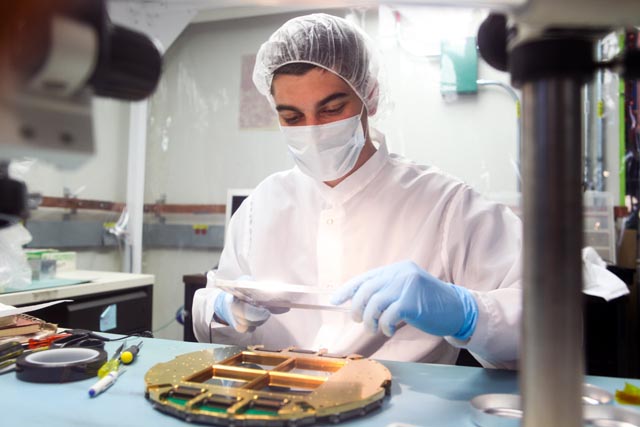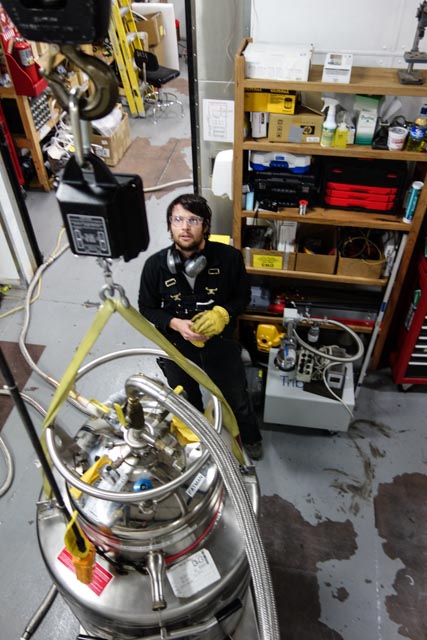|
South Pole Station Archives - 2013 Winter isolation finally comes to an end at South PolePosted November 8, 2013
The final stretch of winter at the South Pole Station October was a busy month, with activities for station opening, including establishing the skiway and bulldozing some of the significant snowdrifts that formed during the past few months. 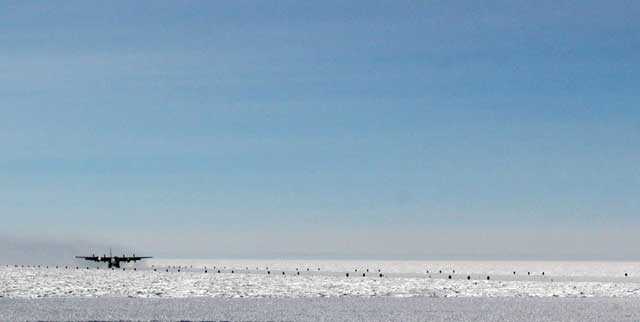
Photo Credit: Marie McLane
The first LC-130 to land at South Pole since mid-February arrives on Nov. 1.
South Pole had something of a soft opening this year. The seal of winter was broken on Oct. 5, with the arrival of two Twin Otters on their way from Rothera Station In past years, the station has opened around Oct. 26. However, more often than not, it was pushed back with weather delays. This year the first plane was scheduled for Nov. 1, and though the weather turned sour the day prior, it cleared up beautifully for the first Herc flight of the summer season. Overall, the weather for October was cooler and clearer than the past two months. On Oct. 5, we hit the high of minus 32.3 degrees Fahrenheit followed by the low of minus 79.2 F on the 11th. Getting the station ready for summer has been a push, but we still managed to get a Halloween party pulled together in the gym. Now the 2013 winter-overs are looking forward to spending the rest of the holiday season in warmer climes. Sun returns to South Pole, along with more warm temperaturesPosted October 21, 2013
September is a month of contradictions for South Pole Station It’s sad to know that we will not see the stars or auroras again, yet the sun is returning, and it’s hard not to feel happy in the light. However, the energy drawn by the sun is short-lived: We’re all tired and still have more than a month to go. The final stretch is sometimes the hardest of all. 
Photo Credit: Marie McLane
The sun rises at the South Pole for the first time in six months on Sept. 21.
September kicked off with high winds and warm temperatures, and only a few clear days to watch the sunrise. It was a blustery month, with a minimum temperature of minus 83 degrees Fahrenheit on Sept. 3. Only ten days later, we set a new maximum temperature record for September at minus 17.9F. The previous record of minus 20.7F was set nearly 20 years ago in 1994. While it was partly cloudy or overcast for much of the month, the clouds cleared for sunrise itself. Stormy weather returned toward the end of the month, however, with winds reaching 40 miles per hour on Sept. 28. The window covers on the station to minimize light pollution for sensitive experiments were taken down during the first week of September. It was still early enough that all we could see was our own reflection, an eerie parallel universe in the panes of tinted glass. 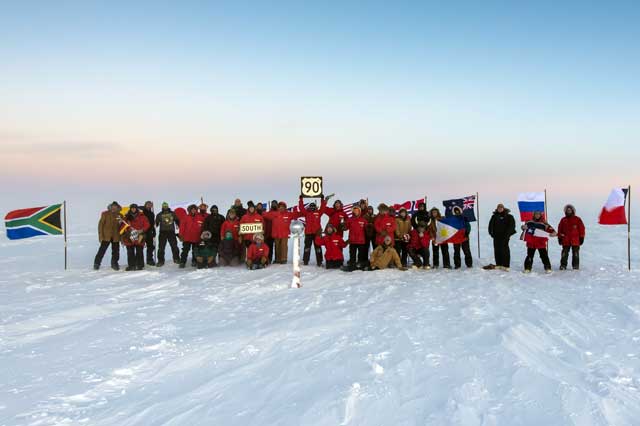
Photo Credit: Marie McLane
The South Pole Station 2013 winter-over crew gathers at the ceremonial pole.
Gradually, the light outside grew, and before I knew it, on Sept. 21, there it was, six whole months since we had bid farewell at sunset on March 21 – an impossibly bright orb just skimming the horizon, wavering and distorted by the atmosphere. It was hard not to stare. Sunrise was celebrated with a formal dinner, though the exuberance of sunset was lacking. The pool tournament was wrapped up in mid-September, and most other activities and events have dwindled to weekly movies or occasional board games. The science projects here have been humming along smoothly. The South Pole Telescope Dark and stormy August gives way to the rising sunPosted September 6, 2013
August is finally over, and the horizon is bright with the promise of the sun’s return. It’s been a stormy month, and the snowdrifts around the South Pole Station Rough redeployment dates for the crew have been issued, and folks are busy planning adventures for after the season. Meanwhile, we continue to find ways to recreate on the Ice: Soccer, badminton, and the pool tournament are still going strong. This past weekend, a group got together and transformed the dining hall into a 1950s style burger bar, complete with wait staff. Afterward, we had a showing of the Antarctic Winter International Film Festival submissions. It was a good change of pace and interesting to see some of the other stations’ entries. The IceCube Neutrino Observatory The weather here at Pole has been all over the board; the first half of the month was stormy and dark. On Aug. 4, we set a new wind speed record for the season, with gusts up to 52 miles per hour (mph). With the cloud cover, temperatures were warm, reaching a high of minus 36.4 Fahrenheit on Aug. 5. It cooled down as it cleared, and during the last week of August we hit minus 97.1F. There were a few good aurora events, though more and more they are being washed out by the rising sun. South Pole enters final stretch of winter seasonPosted August 9, 2013
We have reached the final stretch of true darkness here. The black sky above shimmers with a plethora of brilliant stars, as auroras fade in and out. The moon will rise in two weeks, bathing us in its silver light, and by the time it sets again in late August, the first hint of the sun should be visible on the horizon. This past month has gone by quickly. People have hunkered down, waiting for the sun, a plane, or both. We celebrated Christmas in July with a painted and decorated cardboard Christmas tree, a showing of Elf and National Lampoon’s Christmas Vacation, a white elephant gift exchange, and a big Christmas dinner. Weeknights have been busy with soccer and badminton games, and the pool tournament is in full swing with games on Tuesday and Thursday evenings. The research projects here have been operating smoothly with minimal issues — and some maximum results. The South Pole Telescope The find suggests that scientists are close to finding B-modes created by gravity waves, which would have been generated during the rapid Inflation of the universe. Detection of B-mode gravity waves would prop up the theory of Inflation and further support the standard model of cosmology. Link to news: http://news.sciencemag.org/space/2013/07/swirls-afterglow-big-bang-could-set-stage-major-discovery. The IceCube Neutrino Observatory South Pole weather was steady last month, with temperatures ranging from minus 34.4 degrees Fahrenheit to minus 98.3F. We’ve also had quite a few good aurora events! South Pole redefines the idea of cold temperaturesPosted July 19, 2013
We are in the very heart of the long Antarctic winter now, with a little more than four months since the last plane left and roughly four months yet to go until the next flight. Our bright star has finally reached its lowest point (23.5 degrees below the horizon) and will now begin the slow trek back toward us – rising on the September equinox. Midwinter here at the South Pole Station On Friday, June 21, we had the opportunity to speak with some of the first winterovers ever — Polies from the 1957 season who had assembled for their biennial reunion in New Orleans. It was fascinating to hear some of their stories about having dogs on station and what it was like to winter with only a handful of people. They only had high-frequency radio with which to contact the outside world. The recreation schedule has been full, with soccer, badminton, Game of Thrones, and Monday night science lectures/travelogues. The Pool Tournament has begun, and an Open Mic night was a lot of fun. More than half the station showed up to watch a few performances and listen to some great live music. Weather-wise, June has been a month of extremes. We had several back-to-back storms, and on June 22, broke the June wind speed record of 46 mph with gusts up to 51 mph. We also set a new low temperature for the season so far at minus 107.9F on June 8. About a week or so later, on June 19, we reached minus 19.8F, setting the all-time record high for the month June. Despite the warm fronts, we’ve passed the minus 100F threshold five times now. These extreme cold temperatures define a whole new meaning of the word “cold.” Physical properties change. This degree of cold makes metal tracks on the equipment pop and crack, sounding like Rice Crispies. It freezes Sharpie markers after a minute or two, leaving only a streak of black felt scraped off the tip. Filmy plastic bags become so brittle that even being bent by the wind will snap them in half. Elastic bands on headlamps freeze solid, cracking sharply when adjusted or stretched. Rubber seals break in half at the lightest pressure. Metal zippers become cold enough to burn fingers if touched with bare skin. Cameras slow until the shutter freezes in place. Even hard plastic will crack if dropped. My breath freezes in the air so quickly there’s a sound to it — a gentle exhale, silent in warmer temps, produces a rushing sound, as if I were blowing out forcefully. The snow is like Styrofoam; the air perfectly clear. Sound travels amazingly well; footsteps echo and voices carry easily a quarter mile. It’s a cold sharpened by the wind, and with a wind chill of minus 150F, it’s cold enough to cause frostbite after only a few minutes. Bundled up, however, it’s tolerable for an hour or two. The most important part is keeping the mouth covered, as air this cold will burn lungs, resulting in a cough that lasts for several days. Life may have been different at South Pole in 1957 — but the extreme temperatures here will never change. Mercury plunges below minus 100F twice in MayPosted June 7, 2013
Life and science perseveres here at the southernmost station. We are in the heart of winter now, and with the sun at 21 degrees below the horizon, there’s not so much as a hint of light anymore. The moon rises and sets roughly every two weeks. When it’s below the horizon, we are plunged into complete blackness. Then, rising close to full, it brightly illuminates the South Pole Station The month of May has been cold; in fact, the coldest yet this season. On May 5, we finally hit the magic threshold of 100 degrees Fahrenheit below zero! The temperature continued to drop throughout the night, reaching a low of minus 104.3F at 3:25am on May 6. We hit minus 100F again on May 22. At those temperatures physical properties of materials begin to change. The flaps on cardboard triwalls snap clean off before bending; metal becomes brittle; plastic disintegrates; leather and elastic bands shatter; and even our cold-designed AN8 fuel begins to gel. With these cold temperatures the, heaters in some of the outbuildings have been acting up, keeping our facilities engineer and the utilities technicians very busy. While the South Pole Telescope Some exciting events of this past month include the appearance of a rare phenomenon known as Yukimarimos on May 3. A 1999 Nature article described the first scientific description of these snowballs as “delicate needles of hoar frost [that] form on the surface of the snow. Some of these are rolled about by the wind and create these fragile snowballs, which grow to a size of about 30 mm.” Some of the ones we saw exceeded 90mm. These giant snowballs were incredibly fragile; light as air, yet easily destroyed by a strong gust of wind or simply by the force applied in an attempt to pick them up. They congregated under the station and in the hollows between sastrugi, before eventually being blown out onto the plateau. On May 18 we hosted the newly renamed 8th Annual South Pole Indoor Costumed Event (SPICE) 5K. There was a decent turnout, and costumes ranged from a giant banana to Bob the Builder. The course involved 18 laps around the inside of the elevated station, and prizes were awarded for fastest individual, fastest team, and best costume. 
Photo Credit: Felipe Pedreros
Waste management specialist Marie Mclane secures a trash bin outdoors near the station.
This season the greenhouse has been producing lots of kale, chard, lettuce and nasturtiums, as well as a few cucumbers, sugar snap peas and tomatoes. We even had the first Sun Jewel melons and jalapeños of the season, which were sliced up for all to enjoy and celebrated with a small “Farmers Market” gathering. Auroras have become almost a common occurrence, though a good show stills draws a crowd out of the warm station, with photographers armed with tripods and Big Red parkas. Grantee Robert Schwarz All in all, things are well here at the South Pole, with midwinter fast approaching. Extreme temperatures and night sky highlights in April at PolePosted May 10, 2013
The sun has fully set, the moon has risen, and it’s open season on Aurora Australis. South Pole Station The month of April kicked off with the lowest temperature we’ve seen yet this season: minus 98.9 degrees Fahrenheit. Just a week later, it was back up to the month’s high of minus 40.9F on April 9. A series of wind storms came through mid-month, with gusts up to 40 miles per hour. The subsequent drifting and sastrugi are just enough to derail the casual pedestrian craning their neck for a look at the stars and dancing auroras. With temperatures the last few weeks between minus 75F and minus 85F, it’s been too cold to operate much equipment. It’s definitely cold, a whole new meaning of the word for those who are new to the Ice. The soft leather on my camera strap shattered, and extension cords can be cracked in half. Thankfully, our extreme cold weather (ECW) gear has served us well, and everyone’s been fairly well prepared. One would hope, at least, that agreeing to winter at the South Pole would come with the expectation it to be cold. Science here at the South Pole is chugging along smoothly. The IceCube Observatory According to Thomas Gaisser International Yuri’s Night was celebrated on April 12 in honor of Yuri Gagarin, the first man in space. It was complete with space-related — and plain crazy — costumes. On April 25, a more somber event was hosted by our resident Australian for ANZAC (Australia and New Zealand Army Corps) Day, with freshly baked ANZAC biscuits and a showing of Gallipoli. Other social events this past month included bingo, kickball, a movie marathon, and the premier showing of Thin Ice Sun sets at the South Pole with a couple winter-over recordsPosted April 12, 2013
After the longest day — six months of continuous daylight — the sun has finally set and has cast the South Pole Station The official equinox was two minutes after midnight on Thursday, March 21, though we saw beautiful sunset colors through Monday, March 25, before the clouds rolled in. This is a special time of year, and the last time we will see the sun until the southern vernal equinox in September. We celebrated the occasion with a special dinner on Saturday, March 23. A telescope in the station dining hall, or galley, provided some great views and allowed some shots of the green flash. We are now in a period of civil twilight — a couple of stars have popped into view — and it’s getting darker every day. Temperatures dropped in early March, reaching a serious low of minus 91.1 degrees Fahrenheit on March 25. Over the last week of March, however, they’ve risen dramatically to minus 17.3F on March 29, beating the previous maximum temperature record of minus 21.8F set in 2010. The unofficial South Pole winter-over statistics have been completed this year by Bill Spindler, who maintains the southpolestation.com March was full of summer closing activities, as everyone settled into his or her role. The skiway flags are down, and the berms have been flagged. The aircraft fueling module, the cargo yard, and waste yard have been cleaned up and everything either stored on the berms or on sleds pulled out to the “end of the world,” away from the station. Drifting snow during the eight months of winter can be a serious issue. The big bay doors to the various arches that house the garage, power plant and logistics facility have been closed. Window covers will go up next week on the main station building to prevent interference with light-sensitive experiments. The big research projects have all been operating smoothly, with no significant issues. The new Atacama Large Millimeter/submillimeter Array (ALMA) The expedition known as The Coldest Journey South Pole enters winter with crew of 44 peoplePosted March 8, 2013
February was a big month for the South Pole Station The 2012-13 summer field season was successful and productive in the first year of a significantly downsized support population. The peak population fell from about 250 to about 160 this season, as the population aligns with the design of the elevated station, which can house about 150 people. The delayed return of the Air Force C-17 The South Pole entered the winter season a day earlier than planned this year on Feb. 14. It was a dramatic ending to the summer, with one of the final flights boomeranging back to McMurdo due to a mechanical problem. Temperatures on the final day were already dropping precipitously, down to minus 47 degrees Celsius, nearly to the point where the New York Air National Guard’s LC-130 Hercules All the winter-overs came out to send off the last of the summer crew. That first full night of winter, as per tradition, all three versions of The THING (1951, 1982 and 2011) were shown in the gym. Two Twin Otter aircraft remained around station for several days. One plane was working in support of the Italian Antarctic program, and it began the long journey back to Canada through the British Antarctic Survey’s Rothera Station 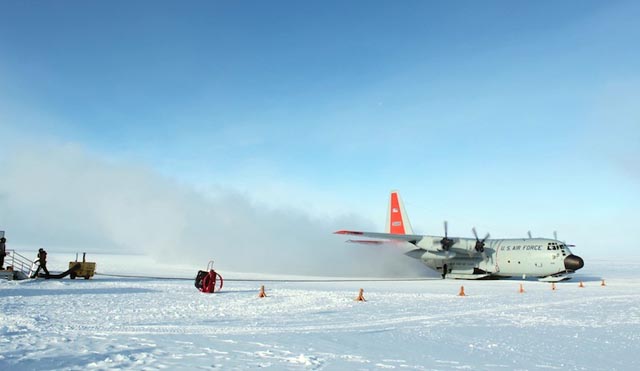
Photo Credit: Marie McLane
The last LC-130 of the 2012-13 summer season leaves a thick contrail in the air due to the extremely cold temperatures.
The other Twin Otter stayed at Pole for another day as a backup for search and rescue operations until a science traverse team returned to McMurdo Station after traveling across the Ross Ice Shelf. Finally, on Monday, Feb. 18, it headed north via Rothera Station, leaving behind 44 souls. The South Pole has been manned year-round since 1957, making this the 56th crew to winter-over. The station has been a hive of activity over the past two weeks, as departments clean up and prepare for the winter. The big projects currently under way mainly involve the airfield — taking down the skiway and approach-way marker flags, rolling up the summer fuel lines and the aircraft fueling module. There are a number of active science projects this winter, both big and small. Some of the larger, long-term endeavors include: IceCube Neutrino Observatory Temperatures since the winter season began have ranged from minus 40C to minus 50C, and while the sun is shining brightly, it’s at about 9 degrees above the horizon, casting long shadows. The sun will set on March 22. New experiments installed at the South Pole in JanuaryPosted February 8, 2013
January is the last full month of the summer field season at the South Pole Station A new experiment was installed last month in the station’s Cryogenics Lab, which is being repurposed because there is no longer a need for liquid helium to the super cool the sensors used for certain telescopes. [See previous article — Full of cold air: South Pole Station makes the most of liquid helium supply.] The installation of the South Pole Lorentz Invariance Test (SPLIT) is being overseen by Princeton University 
Photo Credit: Jeffrey Donenfeld
South Pole research associate Andrew Vernaza, left, and scientist Marc Smiciklas install the SPLIT experiment in the former Cryogenics Lab.
SPLIT aims to detect violations in Lorentz Symmetry by measuring the spin of individual atoms of neon inside its bell-jar-enclosed co-magnetometer. Lorentz Symmetry is the fundamental symmetry of the standard model of particle physics, as well as general relativity, which describes gravity. A violation in this symmetry would suggest that there’s a new element to physics which falls outside of what the current standard model can predict. The SPLIT apparatus arrived in January. One of the main tasks involved alignment of the sensitive laser optics. Smiciklas will work with research associate Andrew Vernaza on developing comprehensive maintenance, testing and operating procedures for the winter. Another new experiment sprung up in January — a new radar was built at the South Pole as part of the Super Dual Auroral Radar Network (SuperDARN) The SuperDARN site installation team, led by principal investigator Bill Bristow Near the end of the month, the SuperDARN team finished verification and testing of the new radar, and is now prepared for a winter of transmitting. Work also continued on a number of other ongoing experiments. Askaryan Radio Array The Askaryan Radio Array (ARA) After the drill team finished drilling the final holes, the ARA deployment team got right to work installing ARA’s sensors deep into the ice. After sensors were deployed, data acquisition boxes were installed near the surface of the ice, and connected to the IceCube Laboratory via buried fiber optic cable. South Pole Telescope January has proven to be a busy and productive month for the South Pole Telescope In particular, the team spent January collecting “point source” data by looking at the planet Venus. These data are used to assess the shape and other characteristics of the telescope’s beam, so that accurate measurements can be made during the winter. So far, the beam has been found to be almost completely Gaussian, or bell-shaped, which is the beam’s ideal shape. The SPT experiment is now looking for signs of inflation, when the universe expanded after the Big Bang, after a five-year project cataloging galaxy clusters in an effort to understand dark energy and other mysteries of the universe. South Pole Remote Earth Science Observatory The South Pole Remote Earth Science Observatory (SPRESO) In addition to monitoring seismic activity in the pursuit of earth sciences, SPRESO “also serves as a United States contribution to the International Monitoring System for the nuclear Comprehensive Test Ban Treaty,” according to the project description on the web site. In January, the SPRESO maintenance team completed calibration and testing of key seismic sensors, removed older equipment from the site, as well as installed a few new sensors. SPUD The Small Polarimeter Upgrade for DASI (SPUD) Scientist Abigail Vieregg said that major upgrades to the sensors took place, including a swap-out of entire focal planes from the five receivers. One of the SPUD receivers was implanted with the refurbished sensor the from now-dismantled BICEP2 In addition to a healthy amount of science progress in January, South Pole also completed a number of station operations and construction projects. In support of the South Pole's continuing sewage disposal and fresh water requirements, the Rodriquez well (Rodwell) #3 was successfully brought online in January. A bulb of water is melted in the ice sheet to provide the station with a fresh water supply. Meanwhile, Rodwell #2 is being converted to contain the station’s sewage outfall. As a result of a bit of differential settling of the ice under the South Pole garage, a routine leveling of the garage support structure took place in January. After inspecting all platform supports, a team led by Josh Miller placed shims underneath the support columns to strategically level the floor that supports the garage structure, walkways and offices. In order to keep proper airflow passing under the elevated station, which prevents the accumulation of snow under the building, the annual snowscaping took place early in January. Snowplow operators carefully shaved down the snow berm that had built up in front of the station, providing a smooth downward slope extending from just in front of the ceremonial South Pole all the way under the building. A grid of marker flags was arranged on the berm to measure snow drift and buildup during the winter months. Tis the season for science upgrades at South PolePosted January 4, 2013
December continues another epic summer season here at the Amundsen-Scott South Pole Station This year at Pole, new experiments are being set up everywhere, and existing experiments are actively being worked on, calibrated and upgraded. 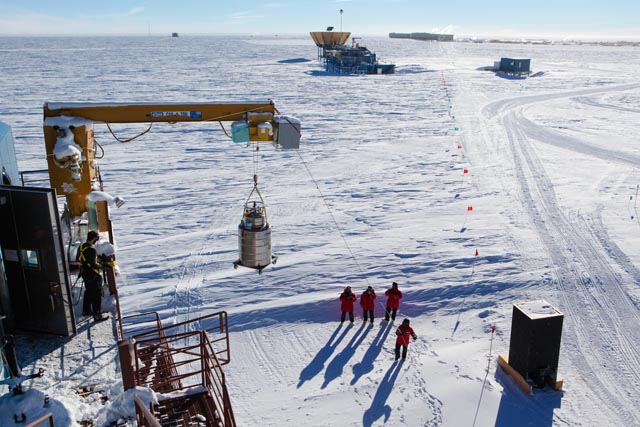
Photo Credit: Jeffrey Donenfeld
The BICEP2 telescope was officially decommisioned and removed from its space at the Dark Sector Lab.
Scientists on the Small Polarimeter Upgrade for DASI (SPUD) In November, the team did a few initial tests on SPUD (also known as the Keck Array), and then warmed up, dismounted and disassembled two of the five sensor-housing cryostats. Once disassembled, the main focal planes were carefully removed by physicist Grant Teply in the Dark Sector Laboratory’s clean room, and then transported back to NASA’s Jet Propulsion Lab Starting in December, the team continued to test and calibrate the assembled cryostats. Additionally, near the end of December, the main focal plane removed from its sister experiment, the BICEP2 telescope Speaking of BICEP2, the CMB telescope, which has been used to investigate the theory of inflation after the Big Bang (like SPUD), was officially decommissioned in December after final calibrations earlier in the season by physicist Jonathan Kaufman. [See previous article — Inflation at South Pole: New telescopes search universe for signs of rapid expansion after the Big Bang.] The end of BICEP2 also means the end of liquid helium at the South Pole. Liquid helium has been used to super-cool the sensors used by some of the experiments during their scans of the CMB. New instruments like SPUD and the South Pole Telescope The final liquid helium fill up for the Cryogenics Laboratory happened in December by cryogenics technician Flint Hamblin. Previously, Hamblin would make intermittent trips on his snowmobile to the Dark Sector Lab (DSL) where BICEP2 was housed to deliver liquid helium, towing a sled with the stainless steel liquid helium dewar strapped to it. [See previous article — Full of cold air: South Pole Station makes the most of liquid helium supply.] It’s been a busy season for a team installing the initial phase of the Askaryan Radio Array (ARA) The ARA team has set up their workshop adjacent to the IceCube In December, the ARA team deployed their drilling rig to the field, and is currently hard at work drilling the first holes of the array. Daily drilling operations continue to go smoothly, as the team overcomes challenges involved with drilling into the soft firn layer of ice. Principal investigator Albrecht Karle Meanwhile, the South Pole’s most famous ongoing neutrino experiment, the IceCube Neutrino Observatory, focused on network upgrades by its two winter-over scientists Blaise Kuo Tiong and Nils Irland. In December, the team completed system monitoring software upgrades, and continues to prepare the lab for upcoming detector operations in January. Research keeps everyone incredibly busy at the station, so we value those moments when we’re allowed to relax a bit. In November, the big moment was Thanksgiving, and by the time it ended, everyone was stuffed. The evening kicked off with an introduction by executive chef James Brown, who shared a bit of South Pole Thanksgiving history. The meal consisted of turkey prepared multiple ways — including smoked turkey prepared by Brown in the South Pole’s very own meat smoker bolted to the Destination Zulu deck. Delicious fixings and sides were also served. After the meal, people relaxed with holiday drinks in the galley, and then escaped down to the supply arches for a late night dance party. DJ Mouse spun MP3s on the iPad while a movie was projected on the wall and the disco ball sparkled. By mid-December, the South Pole Station was decked out in full holiday decorations, and the traditional Christmas Dinner wasn’t far behind it. Tenderloin steak and lobster tail was served, and the station crew broke out into an impromptu holiday dance in the galley immediately following dinner. As is holiday tradition, the after-party rocked down in the logistics arch. |
Home /
Around the Continent /
South Pole Station Archives - 2013
"News about the USAP, the Ice, and the People"



For USAP Participants |
For The Public |
For Researchers and EducatorsContact UsU.S. National Science FoundationOffice of Polar Programs Geosciences Directorate 2415 Eisenhower Avenue, Suite W7100 Alexandria, VA 22314 Sign up for the NSF Office of Polar Programs newsletter and events. Feedback Form |


